 Heaps of exposure this month: in addition to pieces in about four different in-flight mags, if you rush to your local bookist you can find two pieces I did in this this month's Travel + Leisure Southeast Asia, including a roundup of the best places to get your khao soi on in Chiang Mai. I contributed a short piece on Bangkok eats to this month's Saveur (there's also a link on their website, courtesy of Bangkok-based scribe, Jarrett Wrisely). And finally, the 13th edition of Lonely Planet's Thailand is now in shops. I did the Bangkok and Northern Thailand chapters, and am particularly proud of my work on the latter, having made the most significant changes to that chapter in a decade (I still have my copy of Thailand from my first visit in 1997).
Heaps of exposure this month: in addition to pieces in about four different in-flight mags, if you rush to your local bookist you can find two pieces I did in this this month's Travel + Leisure Southeast Asia, including a roundup of the best places to get your khao soi on in Chiang Mai. I contributed a short piece on Bangkok eats to this month's Saveur (there's also a link on their website, courtesy of Bangkok-based scribe, Jarrett Wrisely). And finally, the 13th edition of Lonely Planet's Thailand is now in shops. I did the Bangkok and Northern Thailand chapters, and am particularly proud of my work on the latter, having made the most significant changes to that chapter in a decade (I still have my copy of Thailand from my first visit in 1997).
Hàng Me
 How many different dishes can one make with some form of carbohydrate, shrimp and the occasional pork rind? Leave it to the Vietnamese to have created a fantastic number of dishes using these relatively limited ingredients, all of them creative and delicious.
How many different dishes can one make with some form of carbohydrate, shrimp and the occasional pork rind? Leave it to the Vietnamese to have created a fantastic number of dishes using these relatively limited ingredients, all of them creative and delicious.
I became aware of this at a restaurant called Hàng Me in the central Vietnamese city of Hue. Although located steps from the backpacker strip, the place was filled with locals and littered with the banana leaves used to steam the various dishes -- both signs of good eats.
I started with the dish above, bánh bèo. Mentioned previously, the dish takes the form of a noodle steamed in a ceramic cup and topped with a savoury shrimp mixture and pork rinds. I enjoyed this one even more than the one in Hoi An: the noodle at Hàng Me was soft and slightly salty, and pork rinds make just about anything taste better.
Another variant on the noodle-and-shrimp theme was bánh nam:

This was my favourite item of the meal. The noodle, steamed in a banana leaf:

was again incredibly tender and savoury, and the shrimp topping was deliciously meaty, fatty and rich.
Bánh ram ít were almost identical to bánh bèo, except that the noodle here is perched on a crispy round of pork rind:

Bánh loc, another combination of carb and shrimp, was steamed in what I assume was a bamboo leaf:
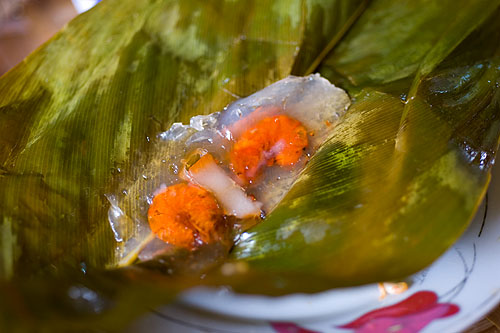
The noodle element was apparently made from tapioca flour and is supplemented with two shrimps and a piece of fatty pork belly. The slightly rubbery texture of the noodle and the fact that the shrimp weren't shelled made this my least favourite item of the meal.
As I was about to leave, they brought out a few slices of freshly-made chả tôm, steamed 'cake' of prawns:
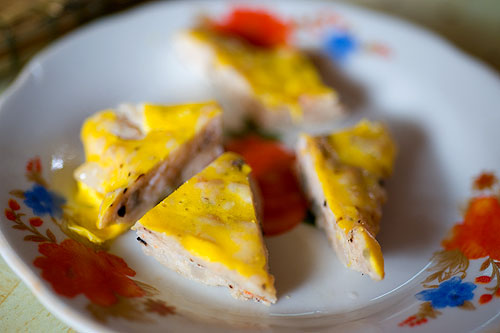
Eggy, meaty, and, at that point at least, graciously lacking a noodle element, it was a perfect end to my most memorable meal in Vietnam.
Hàng Me 45 Võ Thị Sáu, Hue 7am-10pm 054 383 7341
View Thai Eats in a larger map
Bánh Canh Cá Lóc
 Often it's little more than an atmospheric locale that draws me a to a particular vendor or restaurant:
Often it's little more than an atmospheric locale that draws me a to a particular vendor or restaurant:

Such was the case with the ancient dining room of this streetside stall in the central Vietnamese city of Hue. Practically before I really even knew what was being served, I'd taken a seat and placed an order.
It was a few seconds later that I learned that I'd be eating bánh canh cá lóc:

Not knowing exactly what this was, I watched with wonder how patties of a pasty white dough were rolled onto PVC pipes:

Thin slices of the dough were chopped off directly into the broth:

forming the noodles of the dish (shown at the top of this post). I found them a bit chalky, but liked the broth and other ingredients, which included fillets of snakehead fish (the epynomous cá lóc), oily and orange from having been fried with turmeric, chunks of giờ, a type of Vietnamese sausage, a single quail's egg and heaps of green onion.
The sides, present on every table, included banana leaf packages of delicious giờ and nem (fermented pork sausage), and tiny hard-boiled quail's eggs, which were meant to be dipped in a salt and chili mixture. I grew to love these sides in Vietnam, and they made every meal a fun experience.
And if, like me, you're feeling overwhelmed by the sheer number of bánh in Vietnam, have a look at this handy online Banh Guide.
Bánh Canh Cá Lóc Hùng Vương, Hue 4pm-late
View Thai Eats in a larger map
Phương
 I must admit that of the reasons I was most excited to visit Vietnam was because I knew I'd be able to consume bánh mì, Vietnamese-style baguette sandwiches, on a daily basis. This dish is virtually non-existent in Bangkok, and is in my opinion, the perfect sandwich. Unfortunately, other than coincidentally stumbling across the same delicious bánh mì in Saigon that was mentioned at EatingAsia, most bánh mì I encountered during my week in Vietnam were hastily put together and not entirely delicious.
I must admit that of the reasons I was most excited to visit Vietnam was because I knew I'd be able to consume bánh mì, Vietnamese-style baguette sandwiches, on a daily basis. This dish is virtually non-existent in Bangkok, and is in my opinion, the perfect sandwich. Unfortunately, other than coincidentally stumbling across the same delicious bánh mì in Saigon that was mentioned at EatingAsia, most bánh mì I encountered during my week in Vietnam were hastily put together and not entirely delicious.
This was until I arrived in Hoi An and came across Phương. Judging by the throng of impatient customers alone, I knew this would be the bánh mì I had been expecting:
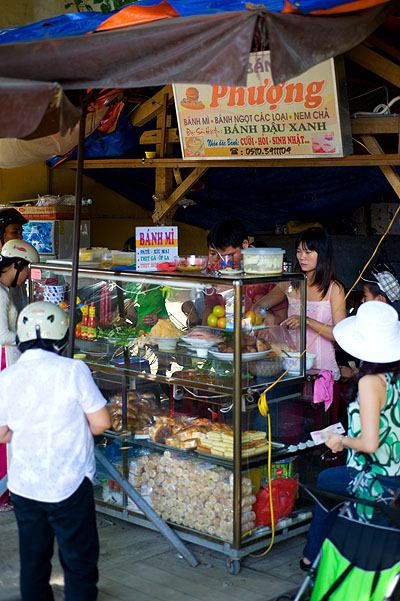
I ordered bánh mì pâté, a crispy submarine of bread filled, assembly line-style, with peppery pork liver pâté, slices of barbecued pork, thin slices of cucumber and tomato, a few sprigs of cilantro, hot pepper sauce and a final sprinkling of Maggi:

The result was crispy, meaty, oily, spicy and veggie; essentially everything a sandwich should be.
Phương Near corner of Bạch Đằng and Nguyễn Duy Hiệu, Hội An Daytime
View Thai Eats in a larger map
Bánh bèo nhân tôm
 I didn't really take to Hoi An. Don't get me wrong, the city's famed Chinese and French-colonial-style buildings were beautiful, and the setting was pleasant. But virtually every single structure seemed dedicated to selling t-shirts or overpriced food to tourists, and there seemed to be more of the latter than locals. And on top of all this, when I was in town, the town's central market was in the process of being rebuilt, which apparently caused many of the local vendors I had read about at EatingAsia to stay at home. That's why, after having walked around in search of a meal on my first day, I was happy to discover the scene below:
I didn't really take to Hoi An. Don't get me wrong, the city's famed Chinese and French-colonial-style buildings were beautiful, and the setting was pleasant. But virtually every single structure seemed dedicated to selling t-shirts or overpriced food to tourists, and there seemed to be more of the latter than locals. And on top of all this, when I was in town, the town's central market was in the process of being rebuilt, which apparently caused many of the local vendors I had read about at EatingAsia to stay at home. That's why, after having walked around in search of a meal on my first day, I was happy to discover the scene below:
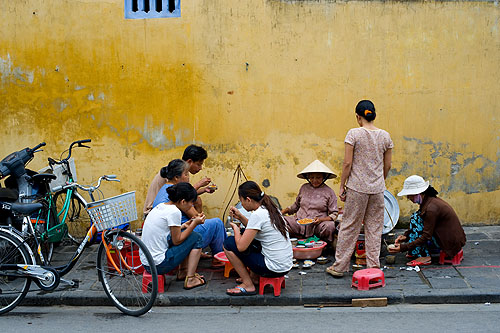
This street vendor was feeding a steady stream of satisfied locals, and was one of the few eating options in Hoi An's old town that didn't seem to be aimed specifically at Western tourists.
A closer look, not to mention help from a friendly local, revealed that she was making bánh bèo nhân tôm (pictured above), a round noodle steamed in a ceramic cup. At each order the woman tops the noodle with a creamy orange mixture made from shrimp, and a sprinkling of crispy croutons:
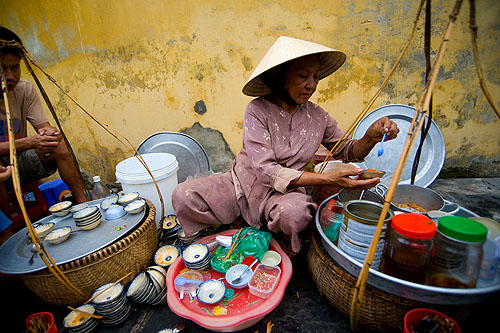
The dish had a lot in common with cao lầu, another of Hoi An's signature dishes, both in the slightly dark colour of the noodle and in the use of croutons. The result was equal parts soft, salty, creamy and crunchy -- a perfect example of the disparate ingredients, flavours and textures the Vietnamese are so absolutely brilliant at combining.
Bánh bèo nhân tôm Hội An Daytime
View Thai Eats in a larger map
Bánh Xèo 46A
 Lonely Planet's Vietnam reckons that Bánh Xèo 46A makes the best bánh xèo in Saigon. I'm certainly no authority on the dish, a type of Vietnamese filled crepe, but I reckon Bánh Xèo 46A do the best version of the dish I've had.
Lonely Planet's Vietnam reckons that Bánh Xèo 46A makes the best bánh xèo in Saigon. I'm certainly no authority on the dish, a type of Vietnamese filled crepe, but I reckon Bánh Xèo 46A do the best version of the dish I've had.
Unlike the bánh xèo served in Laos and Thailand (where it's known as khanom beuang yuan), where the crepe is often paper-thin and crispy, the dish here is pleasantly eggy, hearty and relatively thick. The filling was also slightly different than bánh xèo I've had previously, and in addition to the usual shrimp, sliced shallots and bean sprouts, included thin slices of fatty pork belly. Watching the locals eat I also learned the definitive way to attack a dish of bánh xèo: roll a hearty hunk of the crepe up in an entire lettuce leaf until you have something the size and shape of a spring roll, and using your hand, dip it in the dipping sauce.
Bánh Xèo 46A 46A Đ Đinh Công Tráng 03 824 1110 Breakfast, lunch & dinner
View Thai Eats in a larger map
Vietnoodles
 I had nearly forgotten about the Vietnamese obsession with noodles. Virtually every dish you encounter in this country contains some sort of doughy strand. There are so many noodle options I've yet to even consume a single dish of phở, arguably Vietnam's most recognized noodle dish.
I had nearly forgotten about the Vietnamese obsession with noodles. Virtually every dish you encounter in this country contains some sort of doughy strand. There are so many noodle options I've yet to even consume a single dish of phở, arguably Vietnam's most recognized noodle dish.
Vietnamese noodles usually take the traditional form, such as the dish shown above, mì trứng, wheat and egg noodles with chicken.
Another standard is bún bò Huế, thick udon-like rice noodles served with slices of tender beef:

But often things verge towards the unfamiliar, such as câu lầu, Hoi An's signature dish:

A mixture of light brown and slightly grainy noodles, shredded herbs and slices of pork. The dish is served without broth and is garnished with squares of the noodle that have been deep-fried until crispy.
This noodle dish, also taken in Hoi An, employed short, squiggly lengths of a clear noodle and was served with a small baguette:

And Vietnamese noodles don't even have to be noodle-like, as is the case with bánh bèo:

round disks concealed under a shrimp-based dressing, clear shrimp-filled dumplings and Vietnamese sausage.
Hồng Hạnh
 As mentioned previously, this is a bit of a whirlwind trip, which leaves me relatively little time to explore dining options on my own. Knowing I'd be in Saigon I went directly to EatingAsia's Vietnam archives and found I wasn't staying very far from Hồng Hạnh, a restaurant specialising in Hue-style cuisine they appeared to have much praise for. I jotted down a couple dishes that looked interesting and headed over one evening.
As mentioned previously, this is a bit of a whirlwind trip, which leaves me relatively little time to explore dining options on my own. Knowing I'd be in Saigon I went directly to EatingAsia's Vietnam archives and found I wasn't staying very far from Hồng Hạnh, a restaurant specialising in Hue-style cuisine they appeared to have much praise for. I jotted down a couple dishes that looked interesting and headed over one evening.
Even before your bottom hits the chair at Hồng Hạnh you're presented with two side dishes:

On the left is bản công thành chiến, a deep-fried, meat-filled bun. On the right and wrapped in banana leaves are two different kinds of Vietnamese sausage: giờ, a pepper-studded piece of steamed minced pork, and nem chua, raw fermented pork with plenty of garlic. Both were wonderful, particularly the giờ, and I could have ordered a beer and called it a meal.
But following EatingAsia's tips I ordered bún thịt nướng (no pic) and the dish pictured at the top of this post, bánh đa, a deep-fried rice cracker served with tiny freshwater snails fried with fresh herbs. The former takes the form of thin rice noodles and shredded herbs topped with thin slices of grilled pork. the dish was sweet from the ubiquitous nước chấm, a syrup and fish sauce condiment, and could have used a few more fresh herbs, but instantly reminded me of the fresh Vietnamese flavours I'd been missing since my last visit to the country. I really enjoyed the latter, which was as simple as it was rich and herbal.
Coming back the next day, I arrived just before lunchtime. Business was slow, and after a couple minutes one of the employees came over and sat with me:

She couldn't speak much English, and compensated by helping me order, and eventually, taking it upon herself to season my dishes with copious chili (luckily I like spicy). With her help, I ordered bánh ít trần:

a dish described in the English-language menu as "round patty stuffed with green peas paste and meat taken with taro cake stuffed with meat." The two patties, one of which was fried and crispy, the other steamed and sticky, were stuck together, were served with shredded daikon and carrots, and two types of Vietnamese sausage. Unusual, but tasty.
We also decided on a bowl of bánh canh cua:

a thick crab-based broth with pork and, according to EatingAsia, tapioca starch noodles. The crab wasn't the pleasantest I've ever encountered, but I really enjoyed the fishy heartiness of the soup, the clear slippery noodles and the fact that the Vietnamese will put crushed black pepper on just about anything.
Two excellent meals, and if for some reason I had to head back to Saigon again on this trip, I'd eat there again.
Hồng Hạnh 17A Nguyễn Thị Minh Khai, Saigon 08 3827 4252 Lunch & dinner
View Thai Eats in a larger map
Back in the SRV
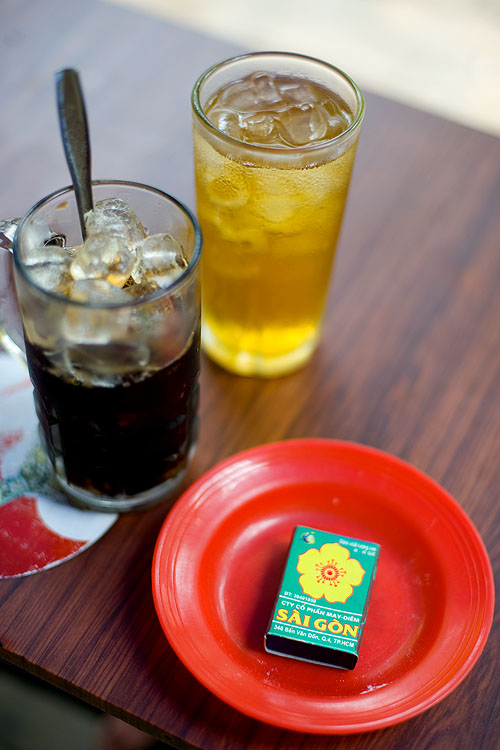 The Socialist Republic of Vietnam, that is.
The Socialist Republic of Vietnam, that is.
Motivated by an open schedule and a temporary lack of work, I've decided to spend a week in Vietnam. Starting in Ho Chi Minh City, I'll be taking the Reunification Express north, with a stop in Hoi An (and possibly Hue), before terminating in Hanoi. It's a bit of a whirlwind trip, and having relatively little time to explore each destination, I'm relying on the generous consul of guidebooks, websites and blogs. Luckily, there's some great eats advice out there, and I'll be posting my pics from various meals and markets as often as I can get a decent WiFi connection.
Nay Yong
 After a long hiatus, I find myself yet again spending quite a bit of time in Bangkok's Chinatown. This is mostly due to some photo assignments I'm working on, but I've also been making some eating trips as I now live only a couple metro stops away. As always, I've got my own repertoire of favourite stalls and dishes, but I'm also making an effort to discover some new places.
After a long hiatus, I find myself yet again spending quite a bit of time in Bangkok's Chinatown. This is mostly due to some photo assignments I'm working on, but I've also been making some eating trips as I now live only a couple metro stops away. As always, I've got my own repertoire of favourite stalls and dishes, but I'm also making an effort to discover some new places.
My most recent discovery is Nay Yong, a streetside curry stall on Thanon Yaowarat, Chinatown's main drag:

It's very similar to the exceedingly popular Jek Pui, located just around the corner, and likewise is associated with mild Chinese/Thai-style curries such as kaeng karii. I chose green curry served with look chin plaa kray, freshwater fish dumplings, and hearty chunks of white radish (shown at the top of this post). The curry is served over rice or khanom jeen noodles (I chose the former), and I also ordered a side of deep-fried kun chiang, a type of Chinese sausage, a traditional accompaniment to this dish. The curry is tasty but mild, and definitely benefits from the optional condiments of sliced fresh chili and a sweet soy sauce. The kun chiang here is also quite nice, and is not as waxy and bland as elsewhere.
There's another "branch" of Nay Yong virtually across the street, in the cluster of street stalls near the entrance to Talat Kao.
Nay Yong Thanon Yaowarat 7pm-late
View Thai Eats in a larger map
Nay Mong
 I last blogged about this shophouse restaurant in Bangkok's Chinatown back in 2007, but after several recent meals there, feel compelled to do a re-run. Actually, despite my numerous visits, I'm somewhat ashamed to admit that I've only ever ordered one dish at Nay Mong: or lua, a crispy oyster and egg omelet (shown here). It eventually took the help of a couple newbies to get me out of my rut.
I last blogged about this shophouse restaurant in Bangkok's Chinatown back in 2007, but after several recent meals there, feel compelled to do a re-run. Actually, despite my numerous visits, I'm somewhat ashamed to admit that I've only ever ordered one dish at Nay Mong: or lua, a crispy oyster and egg omelet (shown here). It eventually took the help of a couple newbies to get me out of my rut.
Visiting the restaurant on a recent eating tour of Chinatown, Hock's father in law, P, was clever enough to order or suan, the 'soft' version the dish (shown above). I'd had this dish elsewhere, but Nay Mong's take was simply head and shoulders above anything else. Like or lua, the dish combines just four ingredients: oysters, egg, green onions and a sticky batter (and of course, seasoning). But in this case, the ingredients are deftly fried, resulting in a light creamy texture that seems to emphasize the eggy and salty flavours of the dish; a profound contrast with the starchy, sticky, heavy pancake that one finds at most places.
I still love or lua, but there is definitely going to be some serious indecision on my next visit. And to add to this, I've also been told on good authority that Nay Mong does a very good crab fried rice.
Maybe next year.
Nay Mong 539 Thanon Phlapplaachai 02 623 1890 5-10pm
View Thai Eats in a larger map
Phat Thai Ratchawong
 I blog about phat Thai on occasion, but mostly for you people. I realize it's huge abroad, particularly in the US, but to be honest, I'm not such a big fan of the stuff. Generally find it kinda stodgy and greasy, particularly when compared to a lot of Thai food out here.
I blog about phat Thai on occasion, but mostly for you people. I realize it's huge abroad, particularly in the US, but to be honest, I'm not such a big fan of the stuff. Generally find it kinda stodgy and greasy, particularly when compared to a lot of Thai food out here.
But occasionally I'll meet a vendor that changes my perceptions of a dish. This was the case a while back when I went to Chinatown with my friend Be. She was born in the area and wanted to take me to some of the places where she ate when she was a kid. One of these was open-air stall serving tiny dishes of phat Thai on Thanon Ratchawong.
I had walked by this stall heaps of times previously, but had never stopped by or noticed anything in particular about it. It took Be's help and a closer look to reveal what I had been missing. To begin with, the couple, like many vendors in Bangkok's Chinatown, fry the dish over hot coals:

which provides the dish with a subtle smokey flavour. The noodles that they use are thinner than regular phat Thai noodles, and are chopped into short lengths. They've also been cooked beforehand, having been previously fried with most of requisite ingredients (sliced shallots, dried shrimp, bits of firm tofu, seasoning, egg). To order, they pull out the pre-cooked noodles and then heat them up with bean sprouts, chopped Chinese chives and additional seasoning. To go orders are served in krathong, the tiny banana leaf cups shown at the top of this post.
The couple work pretty slowly, and there are usually lots of to go orders, so this isn't exactly fast food. But if you're patient, you'll be rewarded with a phat Thai that is rich and liberally-seasoned rather than stodgy and bland (Be reckons they use duck eggs, which could contribute to this). And despite being re-fried, the dish isn't particularly oily either. Not quite sure how they accomplish that.
Phat Tha Ratchawong Thanon Ratchawong Most nights, 7-11pm
View Thai Eats in a larger map
If you find yourself in Bangkok
 and happen upon a drunk Kiwi chef grilling chicken on the side of the street, don't be alarmed; foreigners haven't started taking menial jobs, and food standards haven't yet dropped that much. Rather, Hock and I simply wanted to make frango no churrasco, Portuguese-style grilled chicken.
and happen upon a drunk Kiwi chef grilling chicken on the side of the street, don't be alarmed; foreigners haven't started taking menial jobs, and food standards haven't yet dropped that much. Rather, Hock and I simply wanted to make frango no churrasco, Portuguese-style grilled chicken.
You see, my new place doesn't allow coal-burning stoves, so we asked the streetside Isaan restaurant downstairs if we could use their grill. They were kind enough to oblige, and the next day we brought down two small Thai free-range chickens that I had marinated overnight in my own homemade molho de piri-piri (dried phrik kariang chilies from Mae Hong Son, olive oil, garlic, vinegar, salt):

After removing the birds from the marinade, Hock spatchcocked them two different ways: one he cut down the breastbone and the other down the spine:

After a few minutes of grilling, it appeared that the latter seemed to work better, as it meant that the thicker breast meat was in the centre of the chicken, directly above the fire. Hock also pointed out that, whereas Americans and Australians happily go about spending hundreds and sometimes thousands of dollars on complicated barbecue systems, this guy, like many other Thai street vendors, gets by with an enamel basin and a wire grill. This is really all one needs, since we were grilling, not smoking, and a lid isn't even necessary.
The coals were hot but not flaming, and it took a good 45 minutes to cook, all the while we drank our beers and received strange looks from passing Thais. Our kind sponsor helped us pass the time with shots of yaa dong, a bright-red, sickly-sweet Thai herbal liquor. In return, we gave him some chicken, our recipe and money for new coals.
The result was so tasty we forgot to take a pic of it.
Meanwhile, back home in Portland...
Andy "Richter" Ricker, chef/owner of Pok Pok and Ping, makes som tam on the Today show:
Visit msnbc.com for Breaking News, World News, and News about the Economy
And Nong's Khao Man Gai stall is written up in the Oregonian.
Ko Tek Chiang 3
 Vegetarians, cover your eyes: this is a particularly flesh-laden post. But in its defense I'd have to say that Ko Tek Chiang 3 is one of the best uses of meat that I've encountered in a long time.
Vegetarians, cover your eyes: this is a particularly flesh-laden post. But in its defense I'd have to say that Ko Tek Chiang 3 is one of the best uses of meat that I've encountered in a long time.
The flesh in question is in the form of toon, a Chinese-style slow braise:

It's a simple dish, consisting of cuts of pork or beef simmered until tender and served with a seasoned broth, a pinch of veggies and, if desired, rice.
We stuck with the nuea toon, beef (shown at the top of this post). The slices you see at the top of the bowl are tongue, which have their own particular meaty flavour and were virtually fall-apart tender. Below that you'll find bits of beef similar to the Vietnamese-style corned beef one finds in pho, and the Thai favourite, big strips of gelatinous tendon. The broth has a pleasant amber colour and is peppery to the point of being spicy. The dish is truly, meatily wonderful, but, in what must be the proprietor's bizarre inside joke, is served with some of the worst rice I've encountered anywhere in Thailand.
The other downside: Ko Tek Chiang 3 is located way out in Muang Thong Thani. The "3" in the name implies that there are two branches elsewhere, but they have no business card so I wasn't even able to establish an accurate address for this one. The Google Map location below, pinpointed with the consul of my iPhone, should be accurate though.
But it's worth the drive for the tongue alone.
Ko Tek Chiang 3 Bond St., Muang Thong Thani Lunch
View Thai Eats in a larger map
Phat Thai Fai Look
 The name of this stall means 'rising flame', a reference to how the phat thai here is fried a small wok, which allows the flames to char the noodles. This is a substantial difference with the vast majority of phat thai, as the dish is generally made on a wide flat surface with no flames at all.
The name of this stall means 'rising flame', a reference to how the phat thai here is fried a small wok, which allows the flames to char the noodles. This is a substantial difference with the vast majority of phat thai, as the dish is generally made on a wide flat surface with no flames at all.
The vendor sets up at the little alleyway of 'famous' stalls at the popular Soi 38 night market, and in addition to flames, there are a few more interesting things about how he rolls. He begins the dish by flash-frying shrimp, dried shrimp and tofu in plenty of oil over a very, very hot flame. Next, the fire is turned down and dry rice noodles are moistened with a few splashes of tinned milk and seasoned with sugar, vinegar, dried chili and fish sauce. The heat is increased again and the noodles and seasonings are mixed thoroughly (shown above). After a few seconds, chopped Chinese chives and bean sprouts are tossed in and the dish is removed. In a new wok, he then scrambles a few eggs over a very high heat and when cooked, adds these to the noodle mixture. And when serving the dish, instead of the usual sliced banana flower, he uses a few sprigs of pennywort.
Unfortunately, despite all these clever variations, the result is a pretty bog standard dish of phat thai:

Not bad, but wholly unremarkable, and most sadly, lacking the smokiness that I assume was the intent of making the dish in this manner.
Oh well.
Phat Thai Fai Look Corner Thanon Sukhumvit & Soi 38 8pm-late
View Thai Eats in a larger map
Kuan Phochana
 Bangkok is a decent place to dip your toe in the ocean of regional Thai food, but as soon you attempt to go any deeper than that it's nigh impossible to find anything profoundly good (it's even getting harder to find really good Bangkok food these days, but that's a whole other blog post...).
Bangkok is a decent place to dip your toe in the ocean of regional Thai food, but as soon you attempt to go any deeper than that it's nigh impossible to find anything profoundly good (it's even getting harder to find really good Bangkok food these days, but that's a whole other blog post...).
Take khao soi, for example. If you're a regular reader of the blog you're probably already aware of my love for this northern-style curry noodle dish. I'm constantly seeking the stuff out when up north and am always on the lookout for a decent bowl here in Bangkok, but have mostly come up empty-handed. Other than the excellent khao soi at the Bangkok branch of the famous Chiang Mai institution Lam Duan, which unfortunately is located way outside of town, most khao soi in Bangkok is mediocre, or worse. And disappointingly, such was the case with today's effort, Kuan Phochana (pictured above). The broth of our khao soi kai, chicken khao soi, looked and tasted like little more than sweet-ish coconut milk combined with stale curry powder. Even the sides of pickled mustard greens and the fried chili topping were unpleasant (admittedly, the noodles were decent and authentic though). And to top it off, at 50B for a phiset or 'special' bowl, it was relatively expensive.
Luckily their nam ngiaw:

a northern-style noodle dish usually also served at the same places that serve khao soi, was decent: satisfyingly rich, meaty and fragrant.
So if you're in the neighbourhood, you could do worse than stopping by the for decent nam ngiaw, but I'd recommend saving the khao soi for your next trip up north. (And if you can't make it up north, other, slightly tastier khao soi joints in Bangkok include Khao Soi Sophaphan, Yuy Lee and Maan Mueng.)
Kuan Phochana Soi 22, Thanon Sukhumvit
View Thai Eats in a larger map
Yen Ta Fo JC
 I've recently moved, and after all these years of living in Bangkok, I'm finally living in Bangkok. I'm now based steps from Thanon Silom, Bangkok's de facto financial district, basically in the centre of town. Foodwise, there's an amazing amount of cheap eats around here, strategically positioned and priced to appeal to low- and mid-level office staff. Frankly, much of it doesn't really look that interesting and is emblematic of the spicy, oily stuff that Bangkokians fancy these days. But amongst the riff raff there are a few 'famous' vendors, including a yen ta fo vendor called JC.
I've recently moved, and after all these years of living in Bangkok, I'm finally living in Bangkok. I'm now based steps from Thanon Silom, Bangkok's de facto financial district, basically in the centre of town. Foodwise, there's an amazing amount of cheap eats around here, strategically positioned and priced to appeal to low- and mid-level office staff. Frankly, much of it doesn't really look that interesting and is emblematic of the spicy, oily stuff that Bangkokians fancy these days. But amongst the riff raff there are a few 'famous' vendors, including a yen ta fo vendor called JC.
Despite being a street stall, and despite the fact that your order is most likely be taken by an overweight shirtless man, there's no small amount of pretension and protocol associated with eating here. Seating is strictly relegated, and the vast majority of tables are only available for groups of six. If you come with a friend you're asked to sit on the same side of one of the few tables set aside for individuals. (And don't even think about sitting where the owner sits.) Because the place is so popular and so much care is put into each bowl, you're encouraged to order multiple bowls in one go (this is called bun and stems from the Thai shortening and mispronunciation of the English word 'double'). And after all this, bowls only leisurely arrive at your your table, just as fast as the older couple can put them together.
But it's worth the wait.
The yen ta fo here is slightly sweet for my taste, but admittedly, that's exactly how this dish should be. The broth is balanced out with plenty of deep-fried crispy garlic and slightly salty tao huu yii, a tofu-based condiment that also provides the dish with it's red colour. A bowl comes with excellent-quality fish dumplings, fish cakes, shrimp balls, deep-fried tofu, par-boiled morning glory and pickled squid. And lastly, an order of sen yai here will not get you the usual wide rice noodle sheets, but rather noodles that take the form of thick, old-skool Adidas shoelace-sized strands.
Yen Ta Fo JC Sala Daeng Soi 2 6-9.20am & noon-1.30pm Tues-Fri
View Thai Eats in a larger map
Appetite
Just discovered that shooter Penny De Los Santos has started Appetite, a food-based photo blog. For those not familiar with Penny, she's a talented photojournalist who happens to do a lot of food-related work and brings those photojournalistic sensibilities into her images. It's been a while since I've come across any interesting food-related blogs, so I'm looking forward to following this one.
Naaz
 I've previously blogged about this tiny Muslim restaurant off Thanon Charoen Krung, but having recently been reminded just how good it is, not to mention the fact that it always seems to be empty, felt compelled me to do a re-run.
I've previously blogged about this tiny Muslim restaurant off Thanon Charoen Krung, but having recently been reminded just how good it is, not to mention the fact that it always seems to be empty, felt compelled me to do a re-run.
The dish to order here is khao mok, biryani, in particular, the goat version (pictured above). The rice here is perfectly-cooked, pleasingly oily (with ghee, I suspect) and fragrant, and studded with raisins, cashews and dried spices, while the joint of goat is fall-apart tender and sits beneath the rice in a puddle of rich curry that eventually soaks into the rice, bringing the dish together. It's served with slices of cucumber and onion and a slice of lime and a wonderful homemade relish that's equal parts sweet and sour.
Damn, it's good.
There are a few other similar, although not quite as tasty Muslim places in the area, including Fatima, Muslim Restaurant and Home Islamic Cuisine.
View Thai Eats in a larger map











